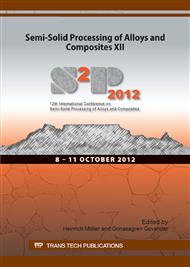p.460
p.466
p.470
p.476
p.482
p.488
p.494
p.500
p.506
Microstructure Characteristics and Semi-Solid Slurry Formation in Binary Mg-Al Alloys Produced by the RheoMetal Process
Abstract:
The RheoMetal process, previously also called the Rapid Slurry Forming process (“Rapid S”) or RSF process, is a novel method to produce high quality, cost effective, semi-solid magnesium slurries for component casting. The RheoMetal process uses an Enthalpy Exchange Material (EEM) as internal cooling to produce the slurry. Typical critical process parameters in the RheoMetal process are alloy content, stirring speed, superheat and EEM to melt ratio. In this study the effects of EEM to melt ratio and superheat on the slurry characteristics was examined for binary Mg-Al alloys in the range 5.8 - 11.2 wt % Al. Samples were quenched after slurry preparation and the microstructure was studied with respect to solid fraction and -Al grain diameter. The solid fraction increased with an increasing EEM to melt ratio for all three Al-contents investigated. Further, it was found that the solid fraction as well as the grain diameter decreased with increasing aluminium content (at constant EEM to weight ratio).
Info:
Periodical:
Pages:
482-487
Citation:
Online since:
October 2012
Authors:
Keywords:
Price:
Сopyright:
© 2013 Trans Tech Publications Ltd. All Rights Reserved
Share:
Citation:


